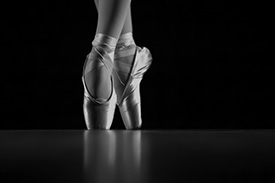 If you’re a professional dancer wearing pointe shoes all day, it is likely that you will experience pain with pointe work. However, it is possible for pointe to be pain-free, especially for dancers who just take weekly classes or who are not aiming for vocational training: those who would like their pointe work to be a little more enjoyable.
If you’re a professional dancer wearing pointe shoes all day, it is likely that you will experience pain with pointe work. However, it is possible for pointe to be pain-free, especially for dancers who just take weekly classes or who are not aiming for vocational training: those who would like their pointe work to be a little more enjoyable.
First and foremost, if you have your shoes fitted correctly, and achieve the right level of strength and mobility in your feet, ankles and legs, you shouldn’t be experiencing any pain. Correctly fitting pointe shoes are absolutely essential. When your feet are still growing and developing, and especially for your first few pairs, make sure you see an experienced pointe shoe fitter, who has access to a wide range of styles to find ones that suit your needs. As everybody’s feet are different – there is no perfect shoe that is right for all dancers – and it is essential that all dancers have shoes that specifically fit their foot type.
For these dancers, it is important for your teacher to provide a structured programme to improve your strength en pointe gradually. It is not just about being up on pointe or down on flat – it’s imperative to learn how to articulate the foot in the shoe in every single rise and tendu. Working through a rise and being able to control your lowering is the most essential part of pointe work and will improve your strength and technique while helping to prevent injuries.
The shoes you wear should therefore be appropriate for your level of pointe work. As a beginner, while just working at the barre, a softer shoe will help you learn to use the foot correctly in the shoe. When you move into doing things like multiple turns in the centre, a stronger, more rigid shoe may be more appropriate. As you progress further with your pointe work, you may find you need a few different pairs of shoes – a really supple pair for barre work; and a stronger, more stable pair for centre work, or variations.
